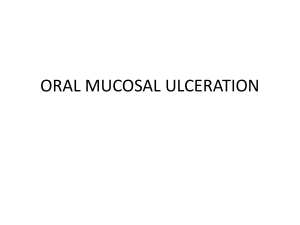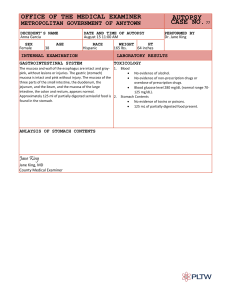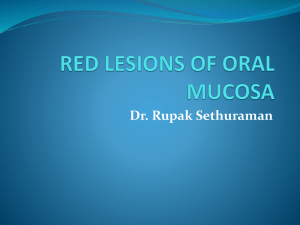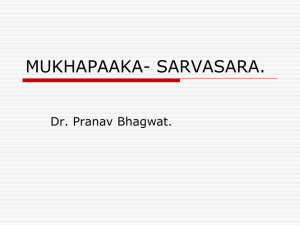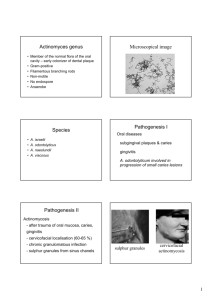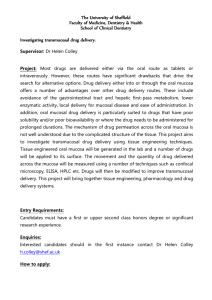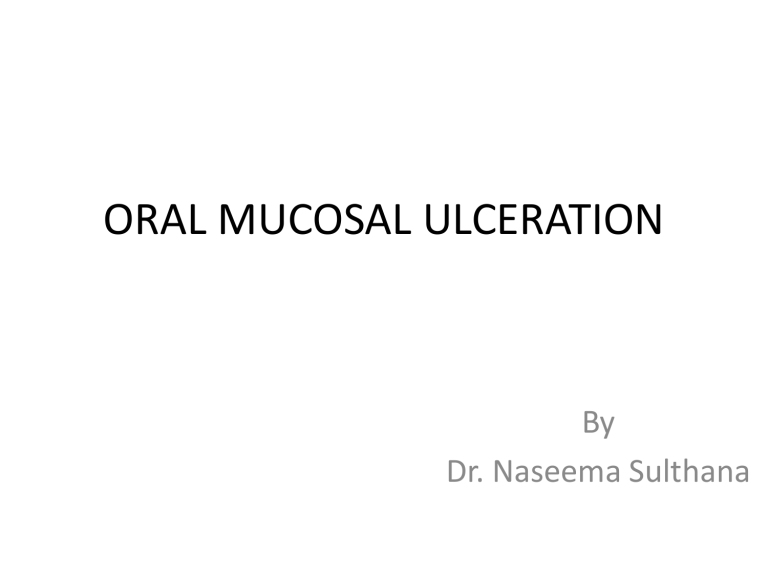
ORAL MUCOSAL ULCERATION By Dr. Naseema Sulthana Palatoglossal arch region • Deep dusky red in color contrast to light red color of surrounding tisue • Painless red macular bands may present • Richer blood supply • Individual normal variation Normal variations of oral mucosa Wide spectrum of pink coors varying from a dark pink(reddish) to a very pale pink(almost white) 1. Lining mucosa --- Reddish pink 2. Masticatory mucosa --- Light ink Protective layer of Keratin Dense sub epithelial connective tissue Color of normal mucosa depends on • • • • Vascularity Thickness & degree of Keratinization Presence of pigmentation Presence of inflammation Why abnormal red? • • • • • • Atrophic epithelium Redcuction in the number of epithelial cells Increased vascularisation Blood vessel enlargment Presence of blood in the tissue Increased hemoconcentration Why abnormal white? • Hyper keratosis • Acanthosis • Intra and extra cellular accumulation of fluid in the epithelium (i.e. Leukedema) • Necrosis of the oral epithelium • Microbes, particulary fungi, produce whitish pseudomembranes • Reduced vascularity in the underlying lamina propria WHITE LESIONS BASED ON ETIOLOGY BASED ON KERATOSIS Developmental, hereditary or Genokeratosis Keratotic Traumatic Viral Inflammatory Bacterial Infective TraumaticFungal Focal(Frictional) Leukodema White sponge nevus Candidiasis Lichen Planus Non Infective Hairy lekoplakia Neoplastic or preneoplastic Metabolic Skin grafts, scars, materia alba Non-Keratotic Leukoplakia Candidal leukoplkia Discoid lupus erythromatosis Mucosal burns HEREDITARY WHITE LESIONS • • • • Leukoedema White Sponge Nevus Hereditary Benign Intraepithelial Dyskeratosis Dyskeratosis Congenita LEUKOEDEMA • Diffuse grayish-white milky appearance of the buccal mucosa • Appearance will disappear when cheek is everted and stretched TREATMENT: • No treatment is indicated for leukoedema since it is a variation of the normal condition. • No malignant change has been reported White spongy nevus • White sponge nevus (WSN) is a rare autosomal dominant disorder. • With a high degree of penetrance and variable expressivity. • It predominantly affects noncornified stratified squamous epithelium. Clinical features of white spongy nevus: • Presents as bilateral symmetric white, soft, “spongy,” or velvety thick plaques of the buccal mucosa. • Other sites in the oral cavity may be involved, including the ventral tongue, floor of the mouth, labial mucosa, soft palate, and alveolar mucosa. TREATMENT : • No treatment is indicated for this benign and asymptomatic condition. • If the condition is symptomatic Patients may require palliative treatment. REACTIVE AND INFLAMMATORY WHITE LESIONS i. Linea Alba (White Line) • Is a horizontal streak on the buccal mucosa at the level of the occlusal plane. • It is a very common finding most likely associated with pressure, frictional irritation, or sucking trauma from the facial surfaces of the teeth. Frictional (Traumatic) Keratosis • Is defined as a white plaque with a rough and frayed surface that is clearly related to an identifiable source of mechanical irritation • Usually resolve on elimination of the irritant. TREATMENT: • Upon removal of the offending agent, the lesion should resolve. • within 2 weeks. Biopsies should be performed on lesions that do not heal to rule out a dysplastic lesion. Cheek biting • Ragged, irregular white tissue of the buccal mucosa in the line of occlusion • May be ulcerated • Due to chewing or biting the cheeks • May also be seen on labial mucosa TREATMENT AND PROGNOSIS • Since the lesions result from an unconscious and/or nervous habit, no treatment is indicated. • For those desiring treatment and unable to stop the chewing habit, a plastic occlusal night guard may be fabricated. Chemical Injuries of the Oral Mucosa • Transient non keratotic white lesions of the oral mucosa . • Are often a result of chemical injuries caused by a variety of caustic agents retained in the mouth for long periods of time. • such as aspirin, silver nitrate, formocresol, sodium hypochlorite, paraformaldehyde, dental cavity varnishes, acid etching materials, and hydrogen peroxide. • The white lesions are attribut-able to formation of a superficial pseudomembrane composed of a necrotic surface tissue and an inflammatory exudates. Actinic Keratosis (Cheilitis) • Actinic (or solar) keratosis is a premalignant epithelial lesion directly related to long-term sun exposure • classically found on the vermilion border of the lower lip as well as on other sun-exposed areas of the skin. • A small percentage of these lesions will transform into squamous cell carcinoma. Nicotine Stomatitis • Palate initially becomes diffusely erythematous and eventually turns grayish white secondary to hyperkeratosis • multiple keratotic papules with depressed red centers correspond to dilated and inflamed excretory duct openings of the minor salivary glands • Histologic appearance of nicotine stomatitis, showing hyperkeratosis and acanthosis with squamous metaplasia of the dilated salivary duct. TREATMENT AND PROGNOSIS: • Nicotine stomatitis is completely reversible once the habit is discontinued. • The lesions usually resolve within 2 weeks of cessation of smoking. Biopsy of nicotine stomatitis is rarely indicated except to reassure the patient. • biopsy should be performed on any white lesion of the palatal mucosa that persists after month of discontinuation of smoking habit Oral Candidiasis Clinical features • Diffuse, patchy, or globular white thickened plaques on the tongue, soft palate & buccal mucosa. • Can be wiped off erythematous, atrophic, or, ulcerated mucosa. • Mild burning pain severe when coagulum scraped. 1-Pseudomembranous Candidiasis • Acute superficial mucosal infection. • Infants & immune compromised. • systemic corticosteroid therapy, chemotherapy, AIDS, or acute debilitating illness Oral Candidiasis / Chronic Atrophic : • Denture sore mouth • Angular cheilitis • Median rhomboid glossitis Denture sore mouth • Denture stomatitis is a common form of oral candidiasis111 • Manifests as a diffuse inflammation of the maxillary denture-bearing areas and that is often associated with angular cheilitis. Angular cheilitis • Angular cheilitis is the term used for an infection involving the lip commissures. • The majority of cases are Candida associated and respond promptly to antifungal therapy. • There is frequently a coexistent denture stomatitis. • Streptococcus. Other possible etiologic cofactors include • reduced vertical dimension • nutritional deficiency (iron deficiency anemia and vitamin B or folic acid deficiency) sometimes referred to as perlèche; • diabetes, neutropenia, and AIDS. • co-infection with Staphylococcus and beta-hemolytic streptococcus. Median Rhomboid glossitis • Erythematous patches of atrophic papillae located in the central area of the dorsum of the tongue • Considered a form of chronic atrophic candidiasis • These lesions were originally thought to be developmental in nature but are now considered to be a manifestation of chronic candidiasis. Candidiasis- Treatment • Mild to Moderate- Topical Therapies Nystatin (suspension 100KU/mL, or 1% cream), Clotrimazole (troche, 10mg) • Moderate to Sever- Systemic Therapies Fluconazole (100mg/day), Itraconzole (oral suspension 10mg/mL) • Topical therapy with nystatin or clotrimazole is effective. Treatment length is usually 10-14 days, follow up Clotrimazole 10mg, 1 tab 5x/day, dissolve slowly and swallow, 10 day treatment • Systemic treatment with fluconazole 100 mg/day for 10 days for oropharyngeal/esophageal disease, follow up RED LESIONS OF ORAL MUCOSA • • • • • • • • Traumatic lesions Infections Developmental anomalies Allergic reactions Immunologically mediated diseases Premalignant lesions Malignant neoplasms Systematic diseases
